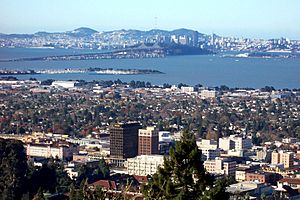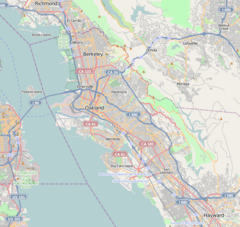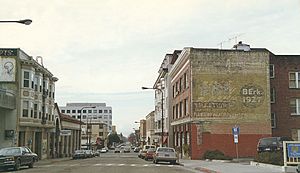Downtown Berkeley, Berkeley, California facts for kids
Quick facts for kids
Downtown Berkeley
|
|
|---|---|
|
Neighborhood of Berkeley
|
|

Downtown Berkeley in the foreground, with San Francisco seen across the Bay
|
|
| Country | United States |
| State | California |
| County | Alameda |
| City | Berkeley |
Downtown Berkeley is the main business area of the city of Berkeley, California, in the United States. It is centered around the crossing of Shattuck Avenue and Center Street. The area stretches north to Hearst Avenue, south to Dwight Way, west to Martin Luther King Jr. Way, and east to Oxford Street. Downtown Berkeley is a major hub for public transportation. Many AC Transit and UC Berkeley bus lines meet here. It also has the city's busiest BART station. This area is home to Berkeley's civic center, high school, and Berkeley City College.
Contents
History of Downtown Berkeley
This area was once a home for the Huichin/Chochen band of the Ohlone people. They were an indigenous group. The location was likely chosen because it was close to Strawberry Creek. This creek used to flow along what is now Allston Way.
Long ago, when the land was part of a huge ranch called Rancho San Antonio, there was a place to cross Strawberry Creek. This crossing was under some oak trees, near where Shattuck Avenue and Allston Way are today. A path or road here connected the homes of two Peralta brothers, Domingo and Vicente.
Early Settlers and Street Names
After the Mexican–American War, four Americans claimed equal parts of land in what is now downtown Berkeley. Their land stretched from Addison Street north to Dwight Way south. One of these people was Francis K. Shattuck. His land was west of what is now Shattuck Avenue. He built a house where the Hotel Shattuck Plaza stands today.
The road going to Oakland near his property was called "Shattuck's road." But the people planning the College of California named the street "Guyot" on their map. That name didn't stick, and the street became "Shattuck Avenue." In the 1890s, Strawberry Creek was put into underground pipes (culverted) through downtown. The oak trees were removed, and Shattuck and University Avenues were improved. Still, the area grew slowly until around the time of the 1906 San Francisco earthquake. After the earthquake, it grew much faster.
Railroads and Transportation
The Central Pacific built its Berkeley Branch Railroad line in 1876. This line connected the area to the Oakland Pier and the transcontinental rail line. This was two years before people living near the University of California and in Ocean View officially formed the city of Berkeley.
The end of the train line at University Avenue was first called the "Terminus." Later, when the line was extended north, it was called Berkeley Station. In the early years, "Berkeley Station" meant downtown Berkeley. The railroad carried both people and goods. A telegraph office and a Wells Fargo office were across from the station.
In 1903, the Key System started its electric train service from Downtown Berkeley to San Francisco. The Southern Pacific railroad then added electric lines in Berkeley in 1911. They moved their downtown freight business south to Ward Street and Shattuck. However, in 1941, Southern Pacific stopped its electric commuter train service. From then until 1958, the Key System was the only electric train service for commuters in downtown Berkeley. Buses replaced the trains from 1958 until today. In 1973, BART opened its own Berkeley station at Center Street and Shattuck. This brought electric train service back to San Francisco and other parts of the Bay Area.
For several years after the Key System's F train stopped running, its tracks stayed in Shattuck Avenue. Parking areas were built in the middle of Shattuck, over the tracks. In the early 1960s, fountains were built in some of these parking areas. They stretched from Center to Haste. But people often put bubble bath in them, so they were soon removed. This happened just before Shattuck Avenue was dug up for the BART subway.
Recent Events
In early 2007, a Marine Recruiting Center moved to downtown Berkeley. It moved from Alameda to be closer to the University of California, Berkeley. This move led to protests from a group called Code Pink. The city council then passed a resolution saying the Marines were "uninvited and unwelcome."
Commercial Life in Downtown Berkeley
Downtown Berkeley has been the main shopping and business area of Berkeley since the railroad station was built. However, it has always had to compete with other shopping areas. These other areas started appearing as early as the 1800s. Some of these were West Berkeley, North Berkeley, and the Telegraph area near the University of California campus. Later, other areas like Elmwood, San Pablo Avenue, South Berkeley, and Thousand Oaks also grew.
Challenges for Businesses
Starting in the 1970s, downtown Berkeley also faced competition from big shopping centers and malls outside Berkeley. These included El Cerrito Plaza, Hilltop Mall, and places in Emeryville. Because of this, several well-known downtown businesses closed. This included two large department stores: Hink's and J. C. Penney. Hink's building was turned into a movie theater and smaller shops.
Other reasons businesses have struggled include high rents, not enough street parking, and higher prices than other places. The city has tried to help by creating an official arts district along Addison Street. They also passed laws to keep businesses open later in other neighborhoods. This was to make downtown more lively at night. To help with parking, the city plans to install digital signs. These signs will guide drivers to available parking spots downtown.
Future Plans for Downtown
Today, downtown Berkeley has many unique small businesses. The Berkeley City Council recently approved a new plan for the downtown area. This plan aims to make downtown more sustainable. It also wants to focus new building projects in this area. The University also plans to build a hotel, conference center, and museum along Center Street.
In 2009, some people gathered signatures to stop this new plan. This made many Berkeley residents upset. Supporters of the plan, including groups like the Sierra Club, said that a denser downtown would reduce carbon emissions. They also pointed out that the plan requires 20% of new housing to be affordable. Opponents argued that the new buildings would be too tall and the housing too expensive.
In recent years, many new and popular restaurants have opened on Shattuck Avenue.




